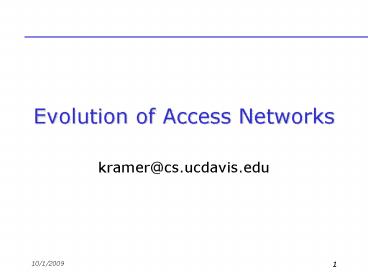Evolution of Access Networks - PowerPoint PPT Presentation
1 / 22
Title:
Evolution of Access Networks
Description:
What is Wide Area Network (WAN)? MCI Network ... San Francisco Bay Area MAN (dark fiber) http://www.mfn.com/network/ map_bayarea.shtm ... – PowerPoint PPT presentation
Number of Views:142
Avg rating:3.0/5.0
Title: Evolution of Access Networks
1
Evolution of Access Networks
- kramer_at_cs.ucdavis.edu
2
What is Wide Area Network (WAN)?
MCI Network http//www1.worldcom.com/global/about/
network/maps/northam/
3
What is Metropolitan Area Network (MAN)?
Metromedia Fiber Network, Inc. San Francisco Bay
Area MAN (dark fiber) http//www.mfn.com/network
/map_bayarea.shtm
4
What is Access Network?
- Access network in Davis (imaginary)
- Connects Central Office to end customers
(subscribers) - Also called subscriber network, last
mile/first mile, local loop
5
Access Network Technologies
- Dial-up
- ISDN
- T1/E1
- DSL
- Cable
- What is next?
6
Analog Dial-up line
- 2.4 / 4.8 / 9.6 / 14.4 / 28.8 / 56 Kbps
- Uses one voice channel (64 Kbps) to reach ISPs
modem across telephone network - Analog from user to Central office, then digital
(DS0) - Actual speed depends on distance
- Charged per minute
7
Integrated Services Digital Network (ISDN)
- 2 bearer channels (B channels) 64 Kbps each. B
channel can be used for voice or data - 1 data channel (16 Kbps) for signaling.
- Total 144 Kbps.
- Digital all the way.
- Charged per minute
8
T1/E1
- T1 24 D0 channels (1.544 Mbps)
- E1 used in Europe (30 D0 channels)
- Uses 4 wires and customer switching unit (CSU)
- Must be provisioned be network operator (very
difficult and expensive) - Permanent circuit! (always on)
9
Digital Subscriber Line (DSL)
- Uses one twisted pair for voice and data
(different frequency) - Data rates from 144 Kbps to 1.5 Mbps (depends on
distance and line quality) - Distance limited to 18000 ft (5.5km). In most
cases is not available if distance from CO
exceeds 12000 ft.
10
Cable Modem
- Tree-like cable network
- Serves many subscribers (2000)
- Requires cable modem and CM terminating system
(CMTS) - Always on
11
Fiber-to-the-Home/Business (FTTH/B)
- Fiber constantly reaching deeper into the
subscriber area - Remote DSLAMs use fiber feeds
- CATV uses fiber from head end to remote nodes
(HFC architecture) - Next generation of access networks will bring
fiber all the way to the customer
12
Point-to-Point vs. PON
13
Passive couplers
- Fused fiber or waveguide technology
- NxN coupler created by combining multiple 2x2
couplers - Splitter coupler with only one input used
- Combiner coupler with only one output used
14
PON topologies
15
WDM vs. TDM PON
- Non-traditional connectivity
- Downstream broadcast
- Upstream Point-to-point, but collisions possible
- Upstream channels must be separated
- WDM
- each ONU must have different ?
- OLT must have a receiver array
- TDM
- Receiver and electronics run at higher speed
- time synchronization
16
Single-Fiber PON
- Use 2 wavelength, but save fiber (repair and
maintenance) - Use TDM in the upstream to avoid collisions
17
ATM Passive Optical Network (APON)
- Uses ATM cells to carry data traffic
- Full Service Access Networks (FSAN) Initiative -
1995 - Too expensive
- Too complicated
- Less efficient (than Ethernet)
- Example For 44-byte IP datagram, Ethernet will
use 64-byte frame 8-byte preamble 12-byte IFG
84 bytesATM will add 12-byte AAL5 and will use
2 cells 106 bytes - For tri-modal packet distribution (CAIDA.org)
cell tax is 13
18
Ethernet Passive Optical Network (EPON)
- Use Ethernet frames to carry the data
- Static bandwidth allocation (SBA) each user
gets fixed slot size - Dynamic bandwidth allocation (DBA) slot size
depends on queue length(request/grant scheme)
Downstream traffic
Upstream traffic
19
IPACT Dynamic Bandwidth Allocation Scheme
20
SBA vs. DBA
IPACT Interleaved Polling with Adaptive Cycle
Time (Photonic Network Communications, vol. 4,
no. 1, January 2002)
21
Upgrade scenarios
- Wavelength upgrade
- Move premium ONUs to separate wavelengths
- Less ONUs per ? more bandwidth per ONU
- Inventory problem (ONUs are different)
- Receiver array in OLT
- Rate upgrade
- Increase rate of EPON (1 Gbps -gt 10 Gbps)
- OLT should receive new rate (from premium ONUs)
and old rates (from non-premium ONUs) - Dispersion penalties affect maximum distance
- Spatial upgrade
- Split 32-user EPON into two 16-user EPONs
- Deploy multiple trunks or splitter in the CO
- Eventually becomes point-to-point topology
22
Conclusion
- Advantages of PON
- Allows longer distances between CO and customer
premises. - Minimizes fiber deployment
- Provides higher bandwidth
- Allows downstream video broadcasting.
- Eliminates multiplexers and demultiplexers in the
field - Transparent. Easy upgrades to higher bit rates or
additional wavelengths































